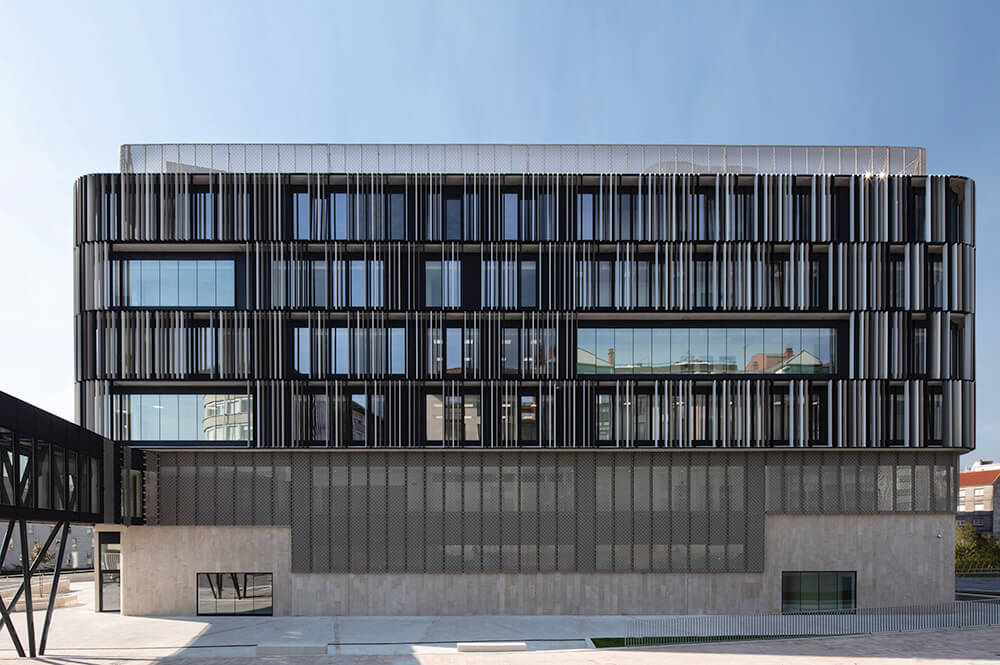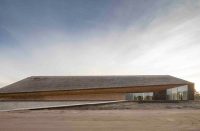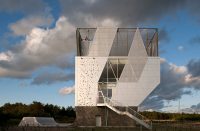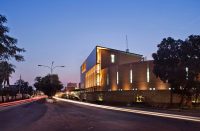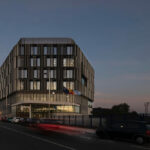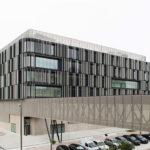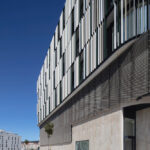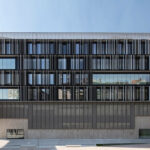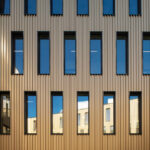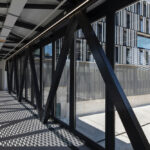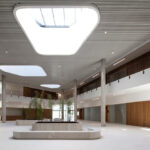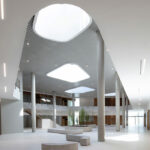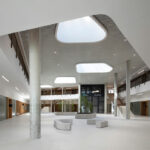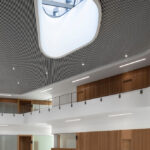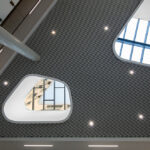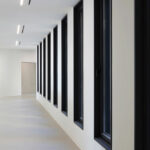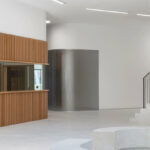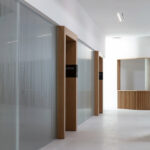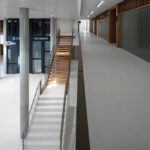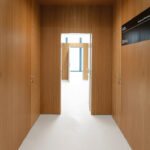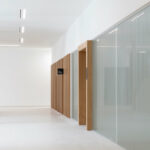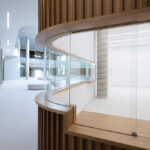Architect(s): Díaz y Díaz Arquitectos
Address: Rúa Hortas, 0, PONTEVEDRA, Spain
Latitude/Longitude: 42.425623,-8.634001
Photographs: Juan Rodríguez
This project was promoted by the board of the Galician Government. It is conceived with the intention of regrouping all the courts in the city of Pontevedra, while creating the space needed in the next years. The old building communicates with the new one through a walkway, forming both a single functional unit. The urban area and the adjacent architecture, especially the existing court are the two clear condition of the exterior image of the building. This is why curve wedges and serial windows are the base of the new building façade.
At the urban level, the building is situated on a trapezoidal plot situated at a considerably high level compared to the train’s arrival and departure routes, making it a reference point from the entrance area of the city via railway.
By its construction, the building generates three different squares, related with the kind of entrance, in function of its use: public, semi-public (for courtroom people) and private (judges’s entry). The idea is to achieve integration in the environment through a compact volume in six heights, being both light and permeable. The plan of the new building follows the pattern already established in this area of neighborhood buildings, based on a closed block with an interior courtyard.
In this kind of buildings, there is an important need of keeping privacy and discretion, so this causes an introverted building, opened to the interior central space but, at the same time, with the force of permeability: this is obtained by a double skin, made by an interior coat totally glazed, and an exterior one with vertical slats serving as solar protection and views.
Because of this, the resultant façade offers different images in function of the position, being porous in a frontal view, and opaque in a lateral view. The colors are the same as the neighboring buildings: white, grey, black and green, which confers a better environment integration.
Position and permeability help the building to act as a focus of light when the exterior light is lower than the interior. On the first to fourth floors a typology of bedroom floors is repeated giving to the facades of both streets, a central corridor that runs throughout the floor, and two bathing areas at the southeast and southwest ends, fronting the block yard.
From the fifth floor, the southeastern end of the floor is reduced compared to the lower floors, leaving a terrace space for a suite. The rest of the floor plan maintains the layout of the lower floors, a corridor that sews all the rooms, and these always give to the façade. The baths are located at the southwest end.
In this intervention the existing structure was preserved and small actions had to be carried out to improve accessibility, and to adapt it to the current regulations and the new use to which it was to be used.
The façade of the building enjoyed a degree of protection, which made it possible to clean and restore the original look of the project, cleaning it out of all the incidentals and the various interventions it had suffered over time. A pergola was created to give shelter and protection in the access, and light is used as a tool to transform the image of the building on special occasions, playing with different ranges of colors.
The basement floors are intended for parking of building workers, archives, warehouses and rooms for facilities.
The ground and first floors, organized around its atrium in double height, are intended for 16 viewing rooms and other services that need more direct public access. The ground floor houses 8 courtrooms, with their rooms for witnesses and/or experts. The largest of them (wedding hall), have direct access from another entrance.
Access control, general registry, Gesell room, civil registry and public toilets consist the rest of the floor. An additional 8 courtrooms, with their witness and/or expert rooms, service of notices and embargoes are located on the first floor. It also houses office of procurators, 2 offices of lawyers, room of togas, 1 office for social graduate, 1 office available, 4 premises for trade union organizations and public toilets.
21 courts, with 7 courts per floor use the upper floors (second, third and fourth) that are organized around the open central courtyard. A judicial office, a judge’s office, a clerk’s office, a living archive and a meeting room for the public and professionals are included in each court. All judicial offices have a public service desk open to the circulation area. The fifth, is kept open.
The building has four vertical communication nodes in all its height with staircase, elevator and toilets and cleanliness. These cores have a mezzanine, with a room of facilities each.
The staircases, lifts and toilets in these centres, under normal building conditions, are used separately by judges and officials.
The building also has general stairs for public use that connect all floors. In the atrium in double height of ground and first floors there is also a larger staircase that communicates both floors.
The two stairs, in the atrium, are open, developing in the space in double height. The general stairs, on upper floors (second to fifth) are developed in a closed enclosure, with fire doors with retainer.
The elements described are organized, on the floors above ground, in the aforementioned arrangement in rings, around the open central courtyard or the covered atrium.
These rings allow the correct segregation of uses and circulations, typical of a judicial building. In fact, the first ring, adjacent to the exterior façade, constitutes private circulation, for judges and officials, with exclusive access to the four vertical nuclei.
The second ring is the intermediate space where all the premises of the functional program are arranged. The third ring, adjacent to the interior façade or to the railing of the atrium, is the public circulation, linked to the stairs and general elevators.
The courtrooms will be one of the most public spaces in the building. It has capacity to accommodate up to 48 persons in the case of the small chambers and 88 persons in the case of the large main chamber, together with the judges and witnesses These chambers are divided into the bench area, raised above the rest of the room 17cm, and the public area. They have entrance on two sides. From the private circulation, for access by the judges, it enters the same level as the podiums. And entry from public circulation.
The building joins the adjoining building by means of a walkway that links the first floor with the floor of view rooms of the existing building, This footbridge extends The baguette enclosure that is arranged throughout the rest of the new building is extended by this footbridge. The joint use of both buildings is allowed by this gateway, premise established from the objectives of the contest. These two buildings function as one, having the entrance and exit at the same point.
The central atrium functions as a large interior square that supports all the project circulations with an open design illuminated by a series of skylights located in the interior patio of type floor, whose metal sheet materiality projects sunlight into the building. The visual connection of the ground floor and the first floor immediately after accessing the enclosure allows a quick and clear reading of the building, being easy to identify the vertical communication spaces and the operation, thanks to the materials.
The materials chosen in this space contribute to the acoustic insulation and maintain a calm atmosphere despite being the most public space in the entire building.
The upper courtyard serves as a meeting space for the standard plants and for the recreation of the workers. The façade of serialized openings is a reflection of the exterior façade, giving a more intimate and warm reflection to the private space.
Text description provided by the architects.
Collaborator: Naiara Montero
Authors: Gustavo Díaz García, Lucas Díaz Sierra, Naiara Montero Viar
Contributed by Díaz y Díaz Arquitectos

